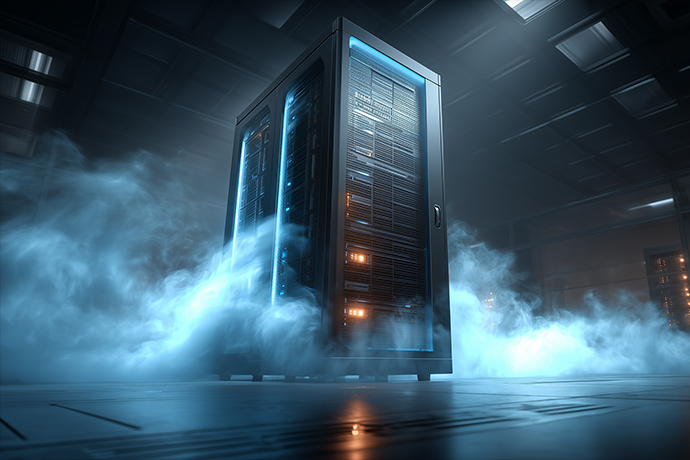Colocation
Colocation
RDHx in Colocation: The Smart Way to Cool High-Density Racks

As artificial intelligence, cloud computing, and high-performance workloads become central to enterprise IT, data centers are adapting to meet significantly higher power and thermal demands. Traditional air-cooling systems continue to play a vital role in data center operations, but as rack densities climb beyond 30kW per rack, Rear Door Heat Exchangers (RDHx) are emerging as increasingly valuable for delivering precise, rack-level cooling in high-density environments. By delivering efficient, rack-level cooling, RDHx technology offers a smarter, more localised way to manage heat in colocation data center environments – without overhauling the entire cooling infrastructure.
RDHx systems are designed to be mounted directly at the rear of server racks, where they intercept hot exhaust air before it enters the data hall. By using chilled water coils to absorb heat, RDHx units cool the air immediately and recirculate it back into the environment at acceptable temperatures. This localised cooling mechanism enables the support of high-density computing loads-up to 50-60kW per rack-without the need to overhaul the entire room’s cooling infrastructure.
RDHx for High-Density Colocation
Colocation facilities are increasingly catering to clients with high-density workloads, especially those running AI model training, financial simulations, or other compute-heavy applications. RDHx presents several advantages for colocation data center providers:
1. Localised Cooling Precision: Rear Door Heat Exchangers (RDHx) offer rack-level thermal management by directly capturing and cooling hot air as it exits the server chassis. Unlike room-based cooling systems that cool the data hall uniformly, RDHx delivers precision cooling exactly at the source. This not only improves thermal efficiency but also contributes to a lower Power Usage Effectiveness (PUE), helping data centers operate more sustainably while maintaining optimal performance for high-density workloads.
2. Maximising Usable Space: By mounting directly onto the rear of server racks, RDHx systems eliminate the need for raised floors, overhead ducting, or additional aisle containment solutions. This design-driven efficiency frees up valuable floor space, allowing operators to accommodate more equipment per square foot. For colocation providers, this translates to increased customer capacity and better utilisation of revenue-generating real estate without compromising airflow management.
3. Built-in Scalability and Mixed-Density Support: RDHx enables seamless integration of mixed-density deployments within the same environment. Data center operators can host racks with varying thermal profiles – such as 10kW general-purpose servers alongside 50kW AI or HPC nodes – within the same row. Since each rack has its own independent cooling unit, this flexibility simplifies capacity planning and accelerates customer onboarding, all while maintaining thermal stability across the floor.
4. Future-Ready, Air-Cooled Compatibility: One of RDHx’s greatest advantages lies in its ability to support conventional air-cooled hardware while accommodating modern high-density demands. It serves as a bridge between traditional cooling systems and advanced liquid cooling, enabling organizations to scale up without the operational complexity or capital investment required for immersion or direct-to-chip solutions. This makes RDHx a highly effective transitional technology for data centers evolving toward next-generation workloads.
Engineering Considerations
RDHx systems require careful planning and execution to deliver optimal performance in colocation settings.
1. Chilled Water Connections: Since RDHx systems rely on chilled water, they require precision plumbing and reliable monitoring devices to ensure safe and effective operation. Water flow rate, inlet temperature, and return temperature must be tightly regulated.
2. Integration with Rack OEMs: RDHx deployment needs to be closely coordinated with server rack manufacturers and IT hardware vendors. Variations in server designs, airflow patterns, and cable management can affect RDHx efficiency and installation feasibility.
3. Power Redundancy: To maintain uptime, RDHx units are typically powered by UPS systems with battery backup. Many also include Automatic Transfer Switches (ATS) to accept dual power sources, thereby ensuring redundancy and resilience.
4. Centralised Humidification Control: Unlike room-based CRAC/CRAH systems, RDHx units do not include built-in humidifiers. Therefore, centralised humidification systems need to be integrated into the overall HVAC design to maintain environmental conditions within ASHRAE standards.
RDHx Implementation: How Yotta Supports High-Density Racks
To efficiently manage high-density racks with loads of up to 60kW, Yotta has integrated Rear Door Heat Exchanger (RDHx) units across its data center infrastructure. These cooling units are installed at the rear of each rack, directing hot exhaust air straight into the RDHx inlets for immediate cooling. This approach ensures that heat is contained and dissipated right at the source, maintaining stable environmental conditions across the data center. Each RDHx is connected to an extended chilled water network, supported by precision valves and monitoring devices that ensure optimal flow and temperature control.
Yotta’s RDHx deployment is carefully aligned with rack OEMs and hardware manufacturers to deliver high-performance, seamless integration. The system is designed with centralised humidifier control to support balanced humidity levels, complementing the localised cooling provided by the RDHx. Each unit is powered by a UPS system with sufficient battery backup, ensuring uninterrupted cooling during power transitions. To further enhance reliability, every RDHx unit is equipped with an Automatic Transfer Switch (ATS) that draws from dual power sources-delivering robust power redundancy for mission-critical workloads.
Conclusion: Future-Proofing Colocation with RDHx
As the demand for compute-intensive applications continues to surge, colocation providers must adopt smarter, more scalable cooling strategies to keep pace. Rear Door Heat Exchangers offer a practical and energy-efficient solution, enabling high-density deployments without compromising space or uptime. With precise, rack-level cooling and integration flexibility, RDHx is becoming the preferred choice for modern data centers. At Yotta, our adoption of RDHx is a strategic step toward next-generation infrastructure. It allows us to support cutting-edge AI and HPC workloads, while maintaining the high availability, energy efficiency, and operational excellence our clients expect.




















